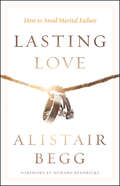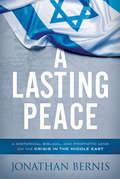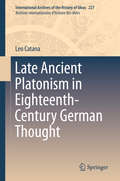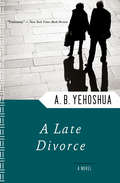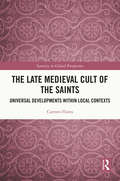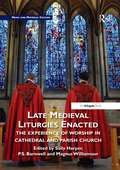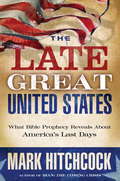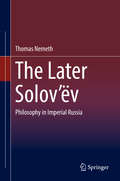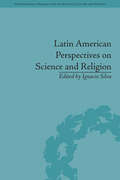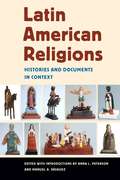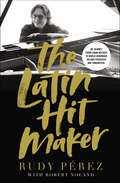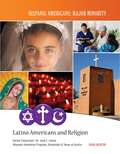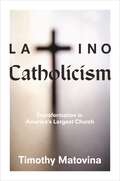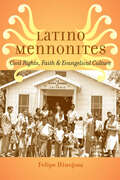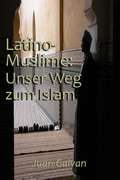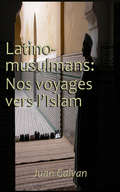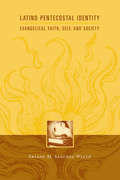- Table View
- List View
Lasting Love: How to Avoid Marital Failure
by Alistair BeggWhat makes love last a lifetime?No one marries intending to fail. Each couple that says "I do" hopes for a long and beautiful life together. But as time passes, many drift apart, and some eventually call it quits.But what about the ones who stay the course, who don&’t just bear through marriage but actually love it? What&’s their secret?It&’s simple, really: there is no secret. They follow God&’s revealed design.In Lasting Love, Alistair Begg unfolds this design. After laying theological foundations, he builds levels of application, showing how God&’s blueprint makes marriages sturdy and vibrant.Ideal for both those considering marriage and those already married, Lasting Love is a comprehensive book on the essentials of a great and godly union, such as:What the Bible says about marriage vows, gender roles, and parentingWhat to look for in a potential spouseHow to cure and prevent marital decayHeed the advice of this pastor who has seen too many marriages come and go. Let yours last a lifetime.Includes a study guide for spouse and group discussion to help you put the book&’s principles to practice.
Lasting Love: How to Avoid Marital Failure
by Alistair BeggWhat makes love last a lifetime?No one marries intending to fail. Each couple that says "I do" hopes for a long and beautiful life together. But as time passes, many drift apart, and some eventually call it quits.But what about the ones who stay the course, who don&’t just bear through marriage but actually love it? What&’s their secret?It&’s simple, really: there is no secret. They follow God&’s revealed design.In Lasting Love, Alistair Begg unfolds this design. After laying theological foundations, he builds levels of application, showing how God&’s blueprint makes marriages sturdy and vibrant.Ideal for both those considering marriage and those already married, Lasting Love is a comprehensive book on the essentials of a great and godly union, such as:What the Bible says about marriage vows, gender roles, and parentingWhat to look for in a potential spouseHow to cure and prevent marital decayHeed the advice of this pastor who has seen too many marriages come and go. Let yours last a lifetime.Includes a study guide for spouse and group discussion to help you put the book&’s principles to practice.
A Lasting Peace: A Historical, Biblical, and Prophetic Lens on the Crisis in the Middle East
by Jonathan BernisThe crisis in the Middle East is not a political issue. It's a spiritual issue. Rapidly unfolding events in the Middle East will shape the future, not just of Israel but of our entire world. This insightful commentary by Rabbi Jonathan Bernis combines historical, biblical, and prophetic teaching to help you understand what&’s happening and how Believers should respond to these events. Drawing from the perspective of a Jewish Believer in Jesus, this book provides a biblical understanding of the complex issues continuing to unfold in the Middle East today and how they relate to key prophecy in Scripture. Discover why there is constant upheaval in the Middle East, what to watch for in the days ahead, and whether peace is really possible. Other books by Rabbi Jonathan Bernis include:Unlocking the Prophetic Mysteries of IsraelA Hope and A Future
Late Ancient Platonism in Eighteenth-Century German Thought (International Archives of the History of Ideas Archives internationales d'histoire des idées #227)
by Leo CatanaThis work synthesizes work previously published in leading journals in the field into a coherent narrative that has a distinctive focus on Germany while also being aware of a broader European dimension. It argues that the German Lutheran Christoph August Heumann (1681-1764) marginalized the biographical approach to past philosophy and paved the way for the German Lutheran Johann Jacob Brucker’s (1696-1770) influential method for the writing of past philosophy, centred on depersonalised and abstract systems of philosophy. The work offers an authoritative and engaging account of how late ancient Platonism, Plotinus in particular, was interpreted in eighteenth-century Germany according to these new precepts. Moreover, it reveals the Lutheran religious assumptions of this new approach to past philosophy, which underpinned the works of Heumann and Brucker, but also influential reviews that rejected the English Plato translator Thomas Taylor (1758-1835) and his understanding and evaluation of late ancient Platonism.
A Late Divorce: A Novel
by A. B. YehoshuaA novel of a Jewish family coming together, and coming apart, by an award-winning &“master storyteller&” (The Wall Street Journal). &“Anyone who has had experience of the sad and subtle ways in which human beings torment one another under license of family ties will appreciate the merits of A.B. Yehoshua&’s A Late Divorce.&” —London Review of Books A powerful story about a family—and a country —in crisis. The father of three grown children comes back to Israel to get a divorce from his wife of many years; another woman, newly pregnant, awaits him in America. Narrated in turn by each family member—husband and wife, sons and daughter, young grandson—the drama builds to a crescendo at the traditional family gathering on Passover eve. &“Each character here is brilliantly realized. . . . Thank goodness for a novel that is ambitious and humane and that is about things that really matter&” —New Statesman &“A master storyteller whose tales reveal the inner life of a vital, conflicted nation.&” —The Wall Street Journal
The Late Great Planet Earth
by Carole C. Carlson Hal LindseyThe impact of The Late Great Planet Earth cannot be overstated. The New York Times called it the "no. 1 non-fiction bestseller of the decade." For Christians and non-Christians of the 1970s, Hal Lindsey's blockbuster served as a wake-up call on events soon to come and events already unfolding -- all leading up to the greatest event of all: the return of Jesus Christ. The years since have confirmed Lindsey's insights into what biblical prophecy says about the times we live in. Whether you're a church-going believer or someone who wouldn't darken the door of a Christian institution, the Bible has much to tell you about the imminent future of this planet. In the midst of an out-of-control generation, it reveals a grand design that's unfolding exactly according to plan. The rebirth of Israel. The threat of war in the Middle East. An increase in natural catastrophes. The revival of Satanism and witchcraft. These and other signs, foreseen by prophets from Moses to Jesus, portend the coming of an antichrist . . . of a war which will bring humanity to the brink of destruction . . . and of incredible deliverance for a desperate, dying planet.
The Late Great Planet Earth
by Hal Lindsey C. C. CarlsonA look at what biblical prophecy tells us about our times, the future, and the return of Jesus Christ.
The Late Medieval Cult of the Saints: Universal Developments within Local Contexts (Sanctity in Global Perspective)
by Carmen FloreaThis is a book that explores the nature of sainthood in a region at the margins of medieval Latin Christendom. Defining the model of sanctity that characterized Transylvania between the fourteenth and sixteenth centuries, the study considers how the cults of saints functioned within specific local social and cultural contexts. Analysing case studies from a multi-ethnic region influenced by both the Latin and Eastern Christian traditions, this book provides a close reading of little-surveyed primary sources and offers a comprehensive understanding of sainthood in Transylvania, enhancing the broader study of medieval saints’ cults and their relationship to social power structures. It will be of great interest to scholars of medieval religion, researchers in medieval studies and religious studies scholars engaged in comparative research.
Late Medieval Liturgies Enacted: The Experience of Worship in Cathedral and Parish Church (Music and Material Culture)
by Sally Harper, P.S. Barnwell and Magnus WilliamsonThis book critically explores ways in which our understanding of late medieval liturgy can be enhanced through present-day enactment. It is a direct outcome of a practice-led research project, led by Professor John Harper and undertaken at Bangor University between 2010 and 2013 in partnership with Salisbury Cathedral and St Fagans National History Museum, near Cardiff. The book seeks to address the complex of ritual, devotional, musical, physical and architectural elements that constitute medieval Latin liturgy, whose interaction can be so difficult to recover other than through practice. In contrast with previous studies of reconstructed liturgies, enactment was not the exclusive end-goal of the project; rather it has created a new set of data for interpretation and further enquiry. Though based on a foundation of historical, musicological, textual, architectural and archaeological research, new methods of investigation and interpretation are explored, tested and validated throughout. There is emphasis on practice-led investigation and making; the need for imagination and creativity; and the fact that enactment participants can only be of the present day. Discussion of the processes of preparation, analysis and interpretation of the enactments is complemented by contextual studies, with particular emphasis on the provision of music. A distinctive feature of the work is that it seeks to understand the experiences of different groups within the medieval church - the clergy, their assistants, the singers, and the laity - as they participated in different kinds of rituals in both a large cathedral and a small parish church. Some of the conclusions challenge interpretations of these experiences, which have been current since the Reformation. In addition, some consideration is given to the implications of understanding past liturgy for present-day worship.
The Late United States: What Bible Prophecy Reveals About America's Last Days
by Mark HitchcockIs it possible the United States, a superpower without peer in history, might not be a key player as the world makes its way down the road to the Battle of Armageddon? This is the central question explored by prophecy expert Mark Hitchcock inThe Late Great United States,a fascinating behind-the-headlines look at numerous current events and how they relate to what the Bible says about the last days. Americans are accustomed to seeing their country center stage as a world power, but as Hitchcock carefully details, this may not be the case inthefinal scene. Based on extensive research of the Bible and other sources,The Late Great United Statesprovides compelling and often surprising answers to questions like these: •Does the Bible say anything about America in the last days? •How could the U. S. fit into God’s prophetic plan? •Will America survive? •Might the anti-Christ come from America? •Could America’s addiction to oil be her undoing? •Will America be destroyed by a nuclear attack? •Could America fall from within as a result of moral corruption? •Is America still a “blessed” nation? •How should individual Christians respond to a world in chaos? Regardless of America's final fate and the outcome of dire events at the end of the age, Hitchcock urges us to find our hope in a God who will not forsake us–no matter what cataclysms we experience on earth. From the Hardcover edition.
The Later Solov’ëv: Philosophy in Imperial Russia
by Thomas NemethThis volume offers a critical examination of the later philosophical views of Vladimir Solov’ëv, arguably Russia’s most famous and most systematic philosopher. It offers a philosophically informed approach to this pivotal figure and to his era. Inside, readers will discover a detailed portrait of the often overlooked evolution of the philosopher’s views during the final two decades of his life. The author explores Solov’ëv’s still evolving aesthetic philosophy and his entry into the lively Russian discussion of free will. The work then turns to the philosopher’s mature statements on many figures from within the history of philosophy. This includes Kant and Hegel. Next, readers will learn about his disagreements with several contemporaries as well as contemporaneous movements. These include positivism and materialism. In addition, the coverage includes an elucidation and examination of Solov’ëv’s final expression of his ethical philosophy as set forth in his major ethical treatise Justification of the Moral Good.The overall picture that emerges is of a much more vibrant and heated philosophical community than typically portrayed in Western secondary literature. The book ends with a reflection on the rise of Solov’ëv as a religious mystic at the expense of a critical evaluation of his thought.
Latin American Perspectives on Science and Religion ("International Perspectives on Science, Culture and Society" #1)
by Ignacio SilvaLatin America plays an increasingly important role in the development of modern Christianity yet it has been underrepresented in current scholarship on religion and science. In this first book on the subject, contributors explore the different ways that religion and science relate to each other.
Latin American Religions: Histories and Documents in Context
by Anna L. Peterson Manuel A. VásquezBefore Columbus, the Americas were populated by many indigenous cultures, with a great diversity of religions. After 1492, European governments and churches dominated religious life. While Roman Catholicism was the official religion, great religious hybridization occurred, mixing European, indigenous, and often African traditions into distinctly New World forms. Latin American Religions provides an introduction through documents to the historical development and contemporary expressions of religious life in South and Central America, Mexico, and the Spanish-speaking Caribbean. A central feature of this text is its inclusion of both primary and secondary materials, including letters, sermons, journal entries, ritual manuals, and ancient sacred texts. These documents provide readers with direct access to the voices of adherents, enabling them to act as academic investigators, experiencing and interpreting the same texts on which historians draw. The documents are framed by substantive introductions which provide both historical context and theoretical insights for the study of these religions traditions and the ways in which they have developed over time. From the religious traditions of the Mayas and Aztecs and of the African diaspora, to official and popular Catholicism, to liberation theology, the rise of Pentecostalism, and emerging trends and new religious movements in Latin America, this new work offers a concise overview of this fascinating field.
Latin America's Neo-Reformation: Religion's Influence on Contemporary Politics
by Eric PattersonThe purpose of this study is to focus on the intersection of religion and politics. Do different religions result in different politics? More specifically, are there significant contrasts between the political attitudes and behavior of Catholics and Protestants in Latin America?
The Latin Church in Norman Italy
by G. A. LoudFirst published in 2007, this was the first significant study of the incorporation of the Church in southern Italy into the mainstream of Latin Christianity during the eleventh and twelfth centuries. Professor G. A. Loud examines the relationship between Norman rulers, south Italian churchmen and the external influence of the new 'papal monarchy'. He discusses the impact of the creation of the new kingdom of Sicily in 1130; the tensions that arose from the papal schism of that era; and the religious policy and patronage of the new monarchs. He also explores the internal structures of the Church, both secular and monastic, and the extent and process of Latinisation within the Graecophone areas of the mainland and on the island of Sicily, where at the time of the Norman conquest the majority of the population was Muslim. This is a major contribution to the political, religious and cultural history of the Central Middle Ages.
El Latin Hit Maker
by Rudy PérezPor primera vez, Rudy Pérez, leyenda de música, comparte su extraordinario proceso desde un pobre niño refugiado en Miami hasta la composición de las mejores canciones de éxito en el escenario mundial. Nombrado el compositor latino más exitoso de la historia, Rudy Pérez es el creador de algunos de los discos más vendidos de Beyoncé, Julio Iglesias, Christina Aguilera e Il Divo.En sus exclusivas memorias, Rudy cuenta sobre su infancia en Cuba y las apasionantes visitas a su padre en la cárcel durante el apogeo de la revolución comunista. Al mirar atrás al peligroso escape de su familia en uno de los últimos vuelos de la libertad a los Estados Unidos, Rudy nos cuenta sobre los años de pobreza y lo que es crecer en un vecindario asolado por el crimen. Estos recuerdos contrastan con los tiernos momentos de baile con sus hermanos junto la banda de música, escuchando los clásicos favoritos de su madre y balanceándose con melodías de blues junto a su padre. A una temprana edad, Rudy intentó recrear la música que amaba, y su talento lo llevó a una carrera sin precedentes con más de trescientas canciones exitosas.Con años de arduo trabajo, creatividad incesante y una fuerte fe, Rudy fue el primer artista de música latina en ganar el Premio Billboard Producer of the Decade. Repasando su legado ganador de cinco Premios Grammy, él comparte historias de fe poco conocidas y anécdotas de su trabajo con estrellas como Fergie, Jaci Velasquez, Michael Bolton, Simon Cowell y Sam Moore.El Latin Hit Maker es una lectura obligada para todos los amantes de la música, una historia genuina del paso de la pobreza a la riqueza, llena de inspiración, detalles fascinantes y un poderoso recordatorio de la gracia de Dios y la creatividad transformadora.
The Latin Hit Maker: My Journey from Cuban Refugee to World-Renowned Record Producer and Songwriter
by Rudy Pérez Robert NolandFor the first time, music legend Rudy Pérez shares his remarkable journey from a poor refugee kid in Miami to composing the greatest hit songs on the world stage. Named the most successful Latin songwriter in history, Rudy Pérez is the creator behind some of the bestselling records of Beyoncé, Julio Iglesias, Christina Aguilera, and IL Divo.In his one-of-a-kind memoir, Rudy tells about his childhood in Cuba and the heart-gripping visits to his father in prison during the height of the communist revolution. Tracing his family's perilous escape on one of the last Freedom Flights to America, Rudy opens up about the years of poverty and growing up in a crime-ridden neighborhood. These memories contrast with tender moments of dancing to the stereo with his siblings, nodding along to his mother's classical favorites, and swaying to blues melodies with his father. At a young age, Rudy tried his hand at recreating the music he loved, and his talent led him to an unprecedented career with over 300 hit songs.With years of hard work, ceaseless creativity, and a strong faith, Rudy was the first Latin music artist to win Billboard Producer of the Decade. Looking back over his five-time Grammy winning legacy, Rudy shares little-known stories of faith and behind-the-scenes details of working with stars like Fergie, Jaci Velasquez, Michael Bolton, Simon Cowell, and Sam Moore.A must-read for every music lover, The Latin Hit Maker is a genuine rags-to-riches story filled with inspiration, fascinating details, and a powerful reminder of God's grace and transforming creativity.
Latino Americans and Religion (Hispanic Americans: Major Minority)
by Frank DepietroIn the United States, people of all different backgrounds live together. Today, more than one in eight people in the United States are Hispanic, and Latino communities are an important part America. Hispanic Americans are people from different lands, cultures, and backgrounds--but they share some things in common. One of the most important is their faith. Latinos may be Catholic or Protestant, or they may belong to the Jewish or Muslim faiths; some practice Santeria, a religion that has its roots in Africa. Despite these differences, Hispanic Americans all tend feel religion is very important to their lives. Discover how Hispanic Americans are living out their faith in different ways within the Latino community--and how they are making America a better place in the process!
Latino Catholicism: Transformation in America's Largest Church
by Timothy MatovinaHow Latino Catholics and America are transforming each otherMost histories of Catholicism in the United States focus on the experience of Euro-American Catholics, whose views on social issues have dominated public debates. Latino Catholicism provides a comprehensive overview of the Latino Catholic experience in America from the sixteenth century to today, and offers the most in-depth examination to date of the important ways the U.S. Catholic Church, its evolving Latino majority, and American culture are mutually transforming one another.In Latino Catholicism, Timothy Matovina highlights the vital contributions of Latinos to American religious and social life, demonstrating in particular how their engagement with the U.S. cultural milieu is the most significant factor behind their ecclesial and societal impact.
Latino Families in Therapy, Second Edition
by Celia Jaes FalicovSince its initial publication, this acclaimed work has provided a comprehensive conceptual framework and hands-on strategies for culturally competent clinical practice with Latino families and individuals. Practitioners and students gain an understanding of the family dynamics, migration experiences, ecological stressors, and cultural resources that are frequently shared by Latino families, as well as variations among them. Through in-depth case illustrations, the author shows how to apply a multicultural and social justice lens to assessment and intervention that draw on each client's strengths. Creative ideas are presented for addressing frequently encountered clinical issues and challenges at all stages of the family life cycle. New to This Edition *Reflects the ongoing development of the author's multidimensional model, including additional assessment/treatment planning tools (MECAmaps, MECA genograms and others). *Incorporates the latest clinical research and over a decade of social and demographic changes. *Chapter on working with geographically separated families, including innovative uses of technology. *Chapters on health disparities and on adolescents. *Expanded discussions of second-generation risks and strengths and of same-sex marriage, intermarriage, divorce, and stepparenting.
Latino Families in Therapy, Second Edition
by Celia Jaes FalicovSince its initial publication, this acclaimed work has provided a comprehensive conceptual framework and hands-on strategies for culturally competent clinical practice with Latino families and individuals. Practitioners and students gain an understanding of the family dynamics, migration experiences, ecological stressors, and cultural resources that are frequently shared by Latino families, as well as variations among them. Through in-depth case illustrations, the author shows how to apply a multicultural and social justice lens to assessment and intervention that draw on each client's strengths. Creative ideas are presented for addressing frequently encountered clinical issues and challenges at all stages of the family life cycle. New to This Edition *Reflects the ongoing development of the author's multidimensional model, including additional assessment/treatment planning tools (MECAmaps, MECA genograms and others). *Incorporates the latest clinical research and over a decade of social and demographic changes. *Chapter on working with geographically separated families, including innovative uses of technology. *Chapters on health disparities and on adolescents. *Expanded discussions of second-generation risks and strengths and of same-sex marriage, intermarriage, divorce, and stepparenting.
Latino Mennonites: Civil Rights, Faith, and Evangelical Culture (Young Center Books in Anabaptist and Pietist Studies)
by Felipe HinojosaThe first historical analysis of the changing relationship between religion and ethnicity among Latino Mennonites.Winner, 2015 Américo Paredes Book Award, Center for Mexican American Studies and South Texas College.Felipe Hinojosa's parents first encountered Mennonite families as migrant workers in the tomato fields of northwestern Ohio. What started as mutual admiration quickly evolved into a relationship that strengthened over the years and eventually led to his parents founding a Mennonite Church in South Texas. Throughout his upbringing as a Mexican American evangélico, Hinojosa was faced with questions not only about his own religion but also about broader issues of Latino evangelicalism, identity, and civil rights politics.Latino Mennonites offers the first historical analysis of the changing relationship between religion and ethnicity among Latino Mennonites. Drawing heavily on primary sources in Spanish, such as newspapers and oral history interviews, Hinojosa traces the rise of the Latino presence within the Mennonite Church from the origins of Mennonite missions in Latino communities in Chicago, South Texas, Puerto Rico, and New York City, to the conflicted relationship between the Mennonite Church and the California farmworker movements, and finally to the rise of Latino evangelical politics. He also analyzes how the politics of the Chicano, Puerto Rican, and black freedom struggles of the 1960s and 1970s civil rights movements captured the imagination of Mennonite leaders who belonged to a church known more for rural and peaceful agrarian life than for social protest.Whether in terms of religious faith and identity, race, immigrant rights, or sexuality, the politics of belonging has historically presented both challenges and possibilities for Latino evangelicals in the religious landscapes of twentieth-century America. In Latino Mennonites, Hinojosa has interwoven church history with social history to explore dimensions of identity in Latino Mennonite communities and to create a new way of thinking about the history of American evangelicalism.
Latino-Muslime: Unser Weg zum Islam
by Juan GalvanWie kommt es, dass immer mehr Latinos zum Islam konvertieren? In diesem Buch erzählen zahlreiche Latinos aus vielen verschiedenen Ländern ihre spannende und ganz individuelle Geschichte. Sie berichten von ihren Erfahrungen mit anderen Religionen, mit verschiedenen islamischen Richtungen, mit dem Widerstand der Familie und dem Freundeskreis und immer wieder von der Erfüllung und dem Frieden, die ihnen der Islam gebracht hat.
Latino-Musulmans : Nos voyages vers l'Islam
by Juan GalvanLatino-Musulmans : Nos voyages vers l'islam est un recueil d'histoires sur les voyages personnels de personnes vers la vérité. Il raconte leurs combats, leurs découvertes et leurs révélations pendant leur voyage avant de finalement trouver la paix dans l'islam. De Michael Wolfe, auteur de Hadj : An American's Pilgrimae to Mecca... "Voici un livre qui remplira vos oreilles d'un choeur de voix que vous n'avez peut-être jamais entendu aussi clairement. Ce que j'aime dans cette grande collection de textes de témoignages introduits avec soin est sa variété, son instabilité, son ouverture, sa portée. D'une part, les lecteurs qui connaissent peu l'islam et son histoire seront surpris par l'idée même de convertis à l'islam d'origine hispanique. Ils devraient se préparer à des rappels : l'espagnol est rempli de mots arabes ; les ressemblances architecturales entre le Mexique et le Moyen-Orient ne sont pas accidentelles ; l'Espagne le perle sociale, culturelle et intellectuelle de l'Europe médiévale était remplie de musulmans de La Mecque, de Damas et du Maroc pendant au moins huit siècles ; un grand nombre de catholiques romains et laïques vivent actuellement en Espagne et dans ses lointaines ex-colonoies du Nouveau Monde, qui peuvent, s'ils le souhaitent, retracer leurs arbres généalogiques avec des familles musulmanes anciennes ; et sans oublier bien sûr que Jésus a toujours joué un rôle essentiel dans la théologie islamique et la vie musulmane. D'autre part, les musulmans qui savent aujourd'hui toutes ces choses pourraient également être surpris par le livre de Juan Galvan, car les voix ne vont pas de main morte, ni cachent les aspects problématiques de l'adoption d'une nouvelle religion par choix. Nos voyages est un ensemble de voix humaines réelles se délectant de la beauté de la découverte, mais également prises aux contraintes d'une décision qui peut facilement semer la confusion chez les gens q
Latino Pentecostal Identity: Evangelical Faith, Self, and Society (Religion and American Culture)
by Arlene Sánchez WalshOf the thirty-seven million Latinos living in the United States, nearly five million declare themselves to be either Pentecostal or Charismatic, and more convert every day. Latino Pentecostal Identity examines the historical and contemporary rise of Pentecostalism among Latinos, their conversion from other denominations, and the difficulties involved in reconciling conflicts of ethnic and religious identity. The book also looks at how evangelical groups encourage the severing of ethnic ties in favor of spiritual community and the ambivalence Latinos face when their faith fails to protect them from racial discrimination. Latinos are not new to Pentecostalism; indeed, they have been becoming Pentecostal for more than a hundred years. Thus several generations have never belonged to any other faith. Yet, as Arlene M. Sánchez Walsh articulates, the perception of adherents as Catholic converts persists, eliding the reality of a specific Latino Pentecostal population that both participates in the spiritual and material culture of the larger evangelical Christian movement and imprints that movement with its own experiences. Focusing on three groups of Latino Pentecostals/Charismatics—the Assemblies of God, Victory Outreach, and the Vineyard—Sánchez Walsh considers issues such as the commodification of Latino evangelical culture, the Latinization of Pentecostalism, and the ways in which Latino Pentecostals have differentiated themselves from the larger Latino Catholic culture. Extensive fieldwork, surveys, and personal interviews inform her research and show how, in an overwhelmingly Euro-American denomination, diverse Latino faith communities—U.S. Chicano churches, pan–Latin American immigrant churches, and mixed Latin American and U.S. Latino churches—have carved out their own unique religious space.
